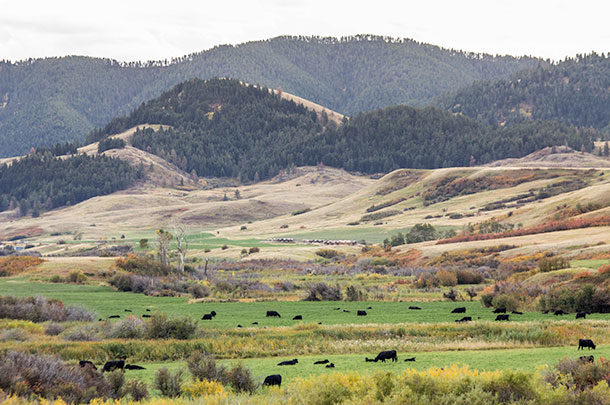Species selection
Selecting the most suitable forage to replant is critical for the overall success of the forage or livestock operation. The best forage to plant usually depends on the type of livestock operation and the other forages available to support that operation.
Many livestock operations have abundant spring pasture from cool-season grasses like smooth bromegrass, orchardgrass and tall fescue. However, in July and August, these pastures are low quality and grow very slowly. More cool-season grass would do little to overcome this summer slump. Instead, plant warm-season grasses like big bluestem, indiangrass or bermudagrass to provide a higher quality forage for later in the growing season that will complement cool-season grass pastures. Likewise, if warm-season grasses dominate existing pastures, plant cool-season grasses for new pasture.
To improve animal performance and reduce nitrogen fertilizer needs, add legumes like clovers, trefoil and alfalfa to the grass mixture.
Do not overlook annual forages as options to provide forage on cropland acres. They provide flexibility for the farming or livestock operation since something different can be planted as forage needs change or crop prices become more attractive. Summer annuals like sorghum-sudangrass or pearl millet can provide abundant summer grazing. Cereal rye is an excellent source of forage for very early spring grazing. Winter wheat can also be used for grazing or it may be planted for forage and harvested later for grain if it is not needed when spring grazing time arrives. Oats and brassicas make excellent fall and early winter forage.
Planting guidelines
Most failed forage plantings are due to inadequate preparation. Hasty decision-making often results in poor soil conditions that result in less than desirable establishment. If possible, prepare land for forage planting while still in annual row crop production.
For example, apply and incorporate lime as needed prior to planting the final year of row crops or immediately following grain harvest. This gives the lime adequate time to neutralize undesired soil acidity.
Seedbed preparation
A major cause of establishment failure is poor seedbed preparation. Firm seedbeds are essential for good seed-to-soil contact at planting. Tillage just prior to planting often results in seedbeds that either are too loose or have compaction zones that restrict root development of young forage seedlings.
Following soybean
Often, the best row crop to grow during the year prior to seeding forages is soybean. Undisturbed soybean stubble nearly always provides an excellent seedbed. If weeds have been controlled well in the soybeans, no-till planting of forages directly into the soybean stubble usually results in excellent seed placement and minimal soil disturbance, which discourages new weed growth.
Following corn
Seeding into heavy corn residue can be difficult. Remove some residue by grazing or baling the corn stalks. Tillage to smooth the field and reduce some of the residue also may be useful.
Following wheat
Stubble from small grains like wheat or oats also makes a fine seedbed. The untilled ground creates a well-packed soil base in which to drill. However, removing straw that might smother new seedlings or cause problems with effective drill operation will increase chances of success. Volunteer small grain seedlings or other weeds can pose a competition threat to perennial grass seedling establishment. Delay planting until at least 30 days post-harvest and control volunteer growth and weeds prior to planting to ensure planted seedlings can establish with limited competition.
Final guidelines
Plant cool-season, perennial pastures shortly before corn planting begins or in late summer at least six weeks before the first hard freeze is expected. Plant warm-season grasses during the time corn normally is planted.
Perennial pasture forages have small seeds, so use a drill to place the seed between 1/4- to 1/2-inch deep into a well-packed seedbed at recommended rates. Use high-quality seeds of varieties known to be adapted to your area.
The most frequent cause of seeding failure and slow establishment of perennial forages is poor weed control. Planting date, strategic mowing and selective herbicide use can help reduce weed pressure. ![]()
Bruce Anderson is an extension forage specialist with the University of Nebraska – Lincoln. Email Bruce Anderson.
Daren Redfearn is a forage and crop residue systems specialist with the University of Nebraska – Lincoln.
Jerry Volesky is a range and forage specialist with the University of Nebraska – Lincoln.
Mitch Stephenson is a range and forage specialist with the University of Nebraska – Lincoln.
PHOTO: If you're converting cropland to pasture, it will make a difference what crop you're following as to when to plant and how to get the best grass stand. Photo by David Cooper.










